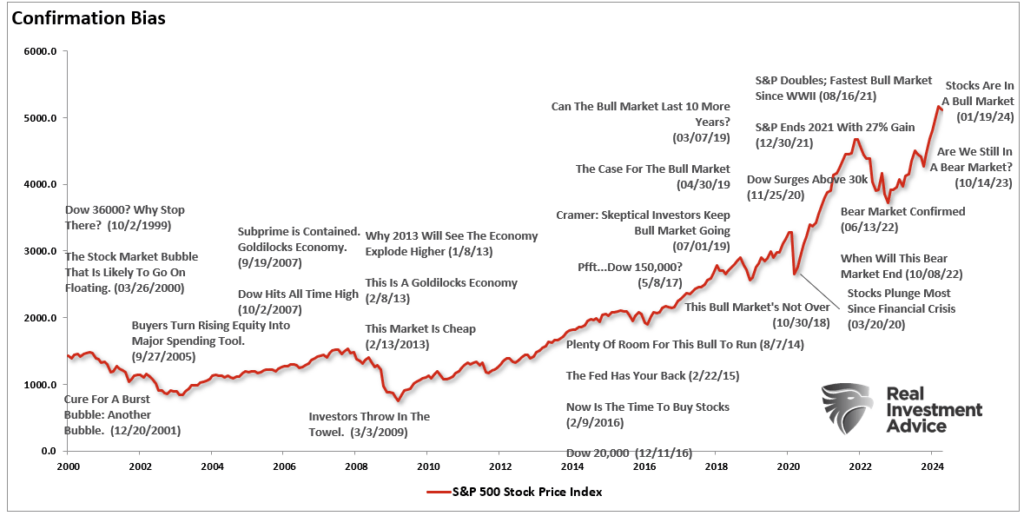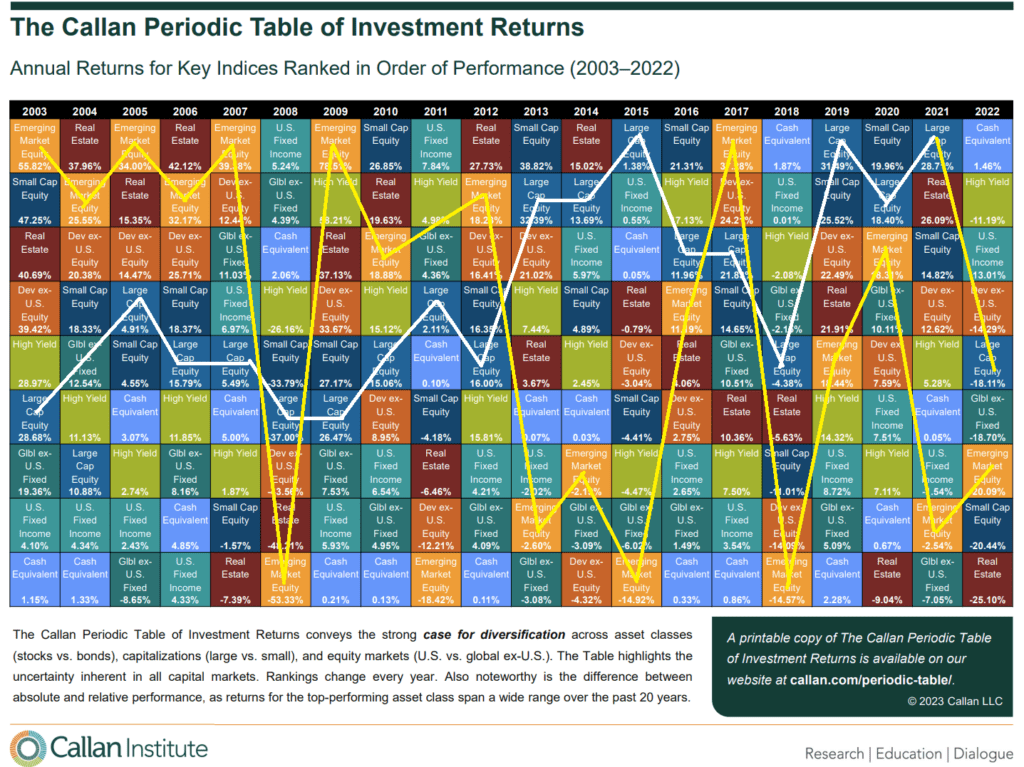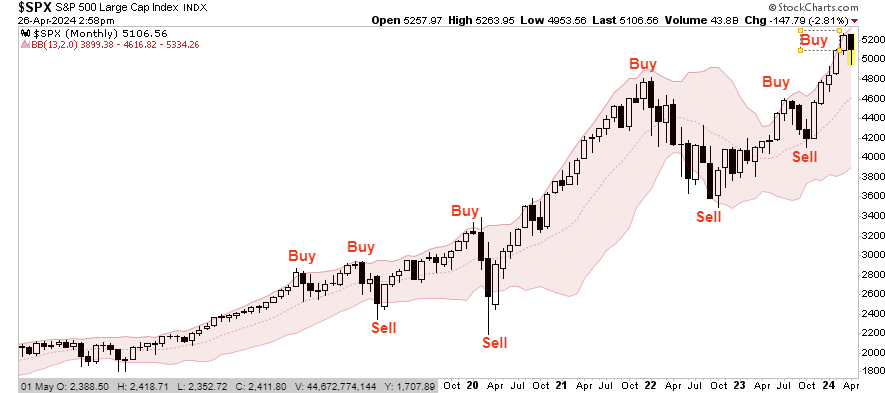Investor psychology is one of the most significant reasons individuals consistently fall short of their investment goals. While one of the most common truisms is that “investors buy high and sell low,” the underlying reason is the behavioral traits that plague our investment decision-making.
George Dvorsky once wrote that:
“The human brain is capable of 1016 processes per second, which makes it far more powerful than any computer currently in existence. But that doesn’t mean our brains don’t have major limitations. The lowly calculator can do math thousands of times better than we can, and our memories are often less than useless — plus, we’re subject to cognitive biases, those annoying glitches in our thinking that cause us to make questionable decisions and reach erroneous conclusions.“
Behavioral traits and cognitive biases are anathemas to portfolio management as they impair our ability to remain emotionally disconnected from our money. As history all too clearly shows, investors always do the “opposite” of what they should when it comes to investing their own money. They “buy high” as the emotion of “greed” overtakes logic and “sell low” as “fear” impairs the decision-making process.
In other words:
“The most dangerous element to our success as investors…is ourselves.”
Here are the top five most insidious behavioral traits keeping us from achieving our long-term investment goals.
Confirmation Bias
Probably one of the most insidious behavioral traits is “confirmation bias.” Confirmation bias is a term from cognitive psychology that describes how people naturally favor information that confirms their previously existing beliefs.
“Experts in behavioral finance find that this fundamental principle applies to investors in notable ways. Because investors seek out information that confirms their opinions and ignore facts or data that refutes them, they may skew the value of their decisions based on their cognitive biases. This psychological phenomenon occurs when investors filter out potentially useful facts and opinions contradicting their preconceived notions.” – Investopedia
In other words, investors tend to seek information that confirms their beliefs. If they believe the stock market will rise, they tend only to read news and information that supports that view. This confirmation bias is a primary driver of individuals’ psychological investing cycles. As shown below, there are always “headlines” from the media to “confirm” an investor’s opinion, whether it’s bullish or bearish.
As investors, we want “affirmation” that our current thought process is correct. That is why we tend to join groups on social media that confirm our thoughts and ideals. Therefore, since we hate being wrong, we subconsciously avoid contradicting sources of information.
For investors, it is crucial to weigh both sides of each debate equally and analyze the data accordingly.
Being right and making money are not mutually exclusive.
Gambler’s Fallacy
The “Gambler’s Fallacy” is another of the more common behavioral traits. As emotionally driven human beings, we tend to put tremendous weight on previous events, believing that future outcomes will be the same.
At the bottom of every piece of financial literature, Wall Street addresses that behavioral trait.
“Past performance is no guarantee of future results.”
However, despite that statement being plastered everywhere in the financial universe, individuals consistently dismiss the warning and focus on past returns, expecting similar results in the future.
This particular behavioral trait is a critical issue affecting investors’ long-term returns. Performance chasing has a high propensity to fail, pushing individuals to jump from one late-cycle strategy to the next. The periodic table of returns below shows this. Historically, “hot hands” last 2-3 years before going “cold.”
I highlighted the annual returns of both Emerging and Large-Cap markets for illustrative purposes. Importantly, you should notice that whatever is at the top of the list in some years tends to fall to the bottom in subsequent years.
“Performance chasing” is a significant detraction from investors’ long-term investment returns.
Probability Neglect
Third, when it comes to “risk-taking,” there are two ways to assess the potential outcome.
There are “possibilities” and “probabilities.”
When it comes to humans, we tend to lean toward what is possible, such as playing the “lottery.” The statistical probabilities of winning the lottery are astronomical. You are more likely to die on the way to purchasing the ticket than winning it. However, it is the “possibility” of being fabulously wealthy that makes the lottery so successful as a “tax on poor people.”
As investors, we neglect the “probabilities” of any given action. Such is specifically the statistical measure of “risk” undertaken with any given investment. As individuals, our behavioral trait is to “chase” stocks that have already shown the largest increase in price as it is “possible” they could move even higher. However, the “probability” is that the price reflects investor exuberance, and most gains have already occurred.
Probability neglect is another contributory factor as to why investors consistently “buy high and sell low.”
Herd Bias
Though we are often unconscious of this particular behavioral trait, humans tend to “go with the crowd.” Much of this behavior relates to “confirmation” of our decisions and the need for acceptance. The thought process is rooted in the belief that if “everyone else” is doing something, I must do it also if I want to be accepted.
In life, “conforming” to the norm is socially accepted and, in many ways, expected. However, the “herding” behavior drives market excesses during advances and declines in the financial markets.
As Howard Marks once stated:
“Resisting – and thereby achieving success as a contrarian – isn’t easy. Things combine to make it difficult; including natural herd tendencies and the pain imposed by being out of step, since momentum invariably makes pro-cyclical actions look correct for a while. (That’s why it’s essential to remember that ‘being too far ahead of your time is indistinguishable from being wrong.’
Given the uncertain nature of the future, and thus the difficulty of being confident your position is the right one – especially as price moves against you – it’s challenging to be a lonely contrarian.”
Investors generate the most profits in the long term by moving against the “herd.” Unfortunately, most individuals have difficulty knowing when to “bet” against the stampede.
Anchoring Effect
Lastly, “Anchoring,” also known as the “relativity trap,” is the tendency to compare our current situation within the scope of our limited experiences. For example, I would be willing to bet that you could tell me exactly what you paid for your first home and what you eventually sold it for. However, can you tell me exactly what you paid for your first soap bar, hamburger, or pair of shoes? Probably not.
The reason is that the home purchase was a major “life” event. Therefore, we attach particular significance to that event and remember it vividly. If there was a gain between the purchase and sale price of the home, it was a positive event, and therefore, we assume that the next home purchase will have a similar result. We are mentally “anchored” to that event and base our future decisions around very limited data.
When it comes to investing, we do very much the same thing. If we buy a stock that goes up, we remember that event. Therefore, we become anchored to that stock instead of one that lost value. Individuals tend to “shun” stocks that lost value even if they were bought and sold at the wrong times due to investor error.
After all, it is not “our” fault that the investment lost money; it was just a bad stock. Right?
Make Better Bad Choices
My nutrition coach had a great saying about dieting; “make better bad choices.”
We are all going to make bad choices from time to time. The goal is to try and make bad choices that don’t have an outsized effect on our plan. When it comes to dieting, if you eat a burger, order it without cheese and mayonnaise.
If you make speculative bets in your portfolio, do it in smaller amounts. Or, if you are leaning towards “panic selling” everything, start by selling some but not all of your holdings.
Importantly, focus on the rules and your investment discipline.
- Do more of what is working and less of what isn’t.
- Remember that the “Trend Is My Friend.”
- Be either bullish or bearish, but not “hoggish.” (Hogs get slaughtered)
- Remember, it is “Okay” to pay taxes.
- Maximize profits by staging buys, working orders, and getting the best price.
- Look to buy damaged opportunities, not damaged investments.
- Diversify to control risk.
- Control risk by always having pre-determined sell levels and stop-losses.
- Do your homework.
- Not allow panic to influence buy/sell decisions.
- Remember that “cash” is for winners.
- Expect, but do not fear, corrections.
- Expect to be wrong, and will correct errors quickly.
- Check “hope” at the door.
- Be flexible.
- Have the patience to allow your discipline and strategy to work.
- Turn off the television, put down the newspaper, and focus on your analysis.
Importantly, keep your market perspectives and behavioral traits in check. Our goal is to ensure that our decisions are influenced by reliable data and psychological emotions.
Most importantly, if you don’t have an investment strategy and discipline you are stringently following, that is an ideal place to begin.
Related: No Signs of Rate Cuts on the Horizon





